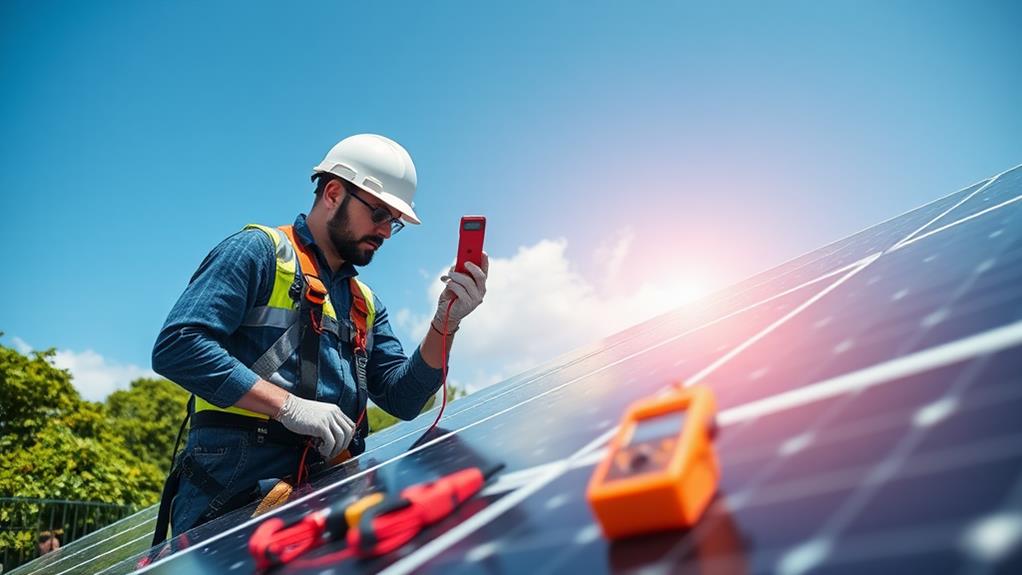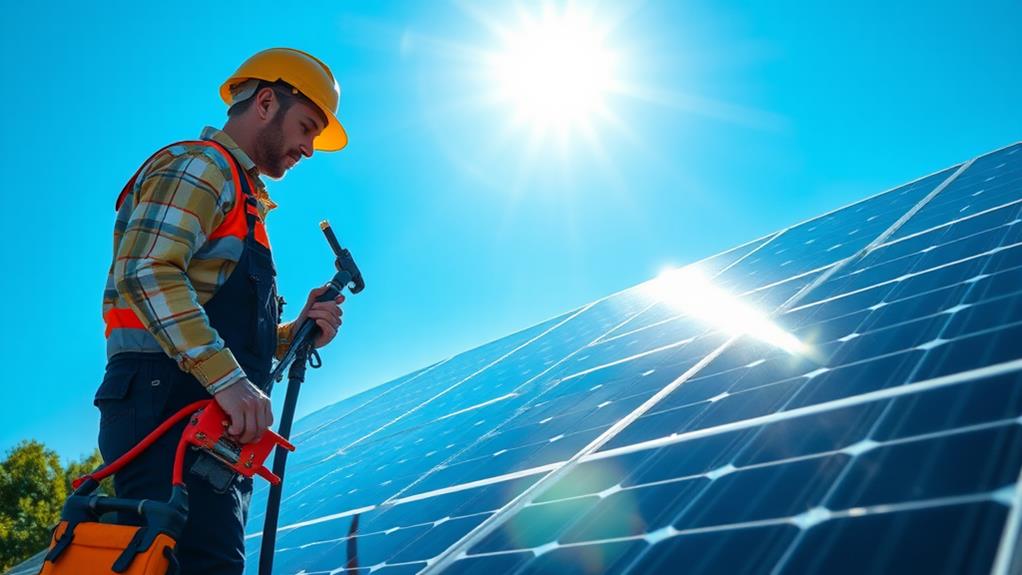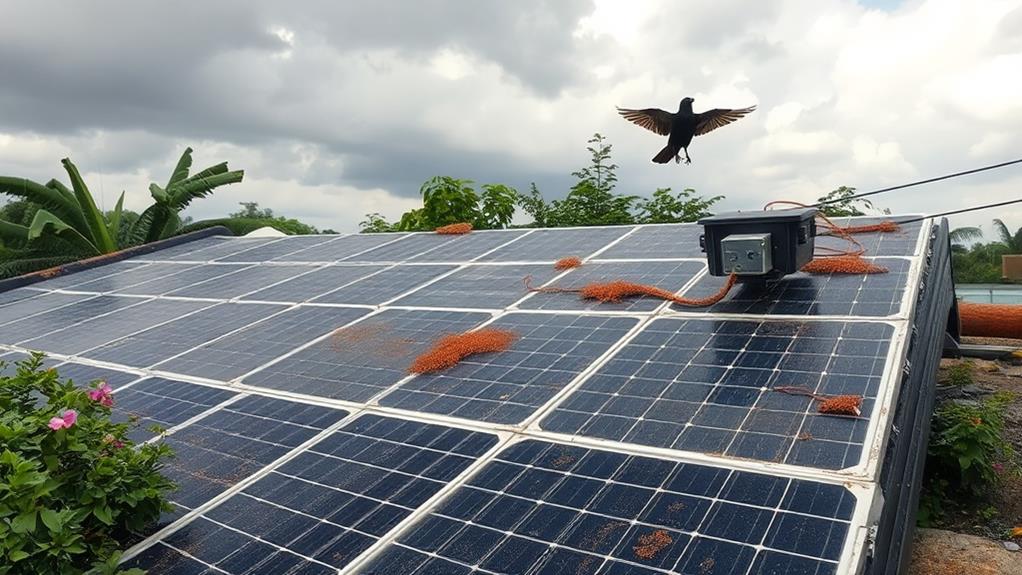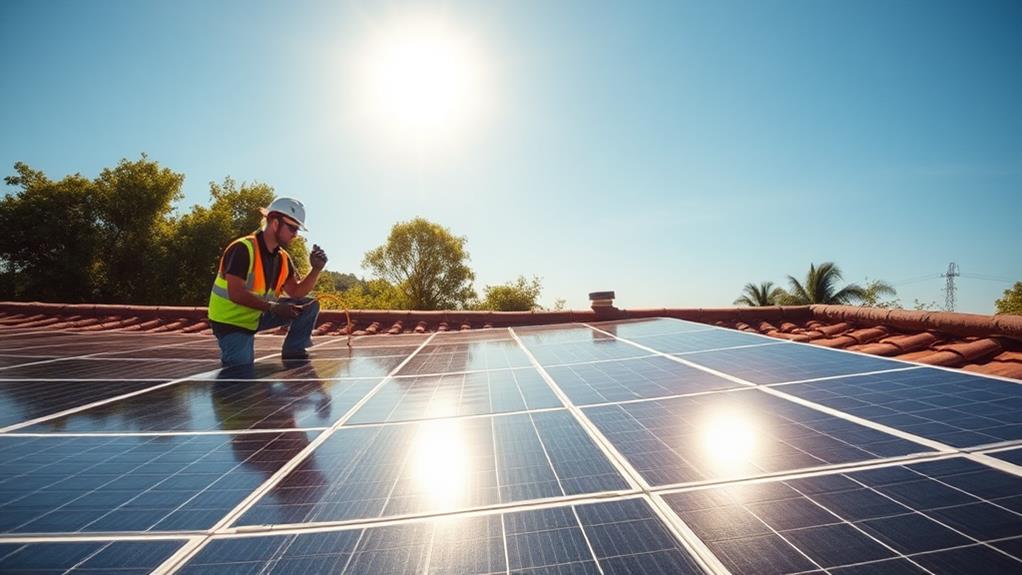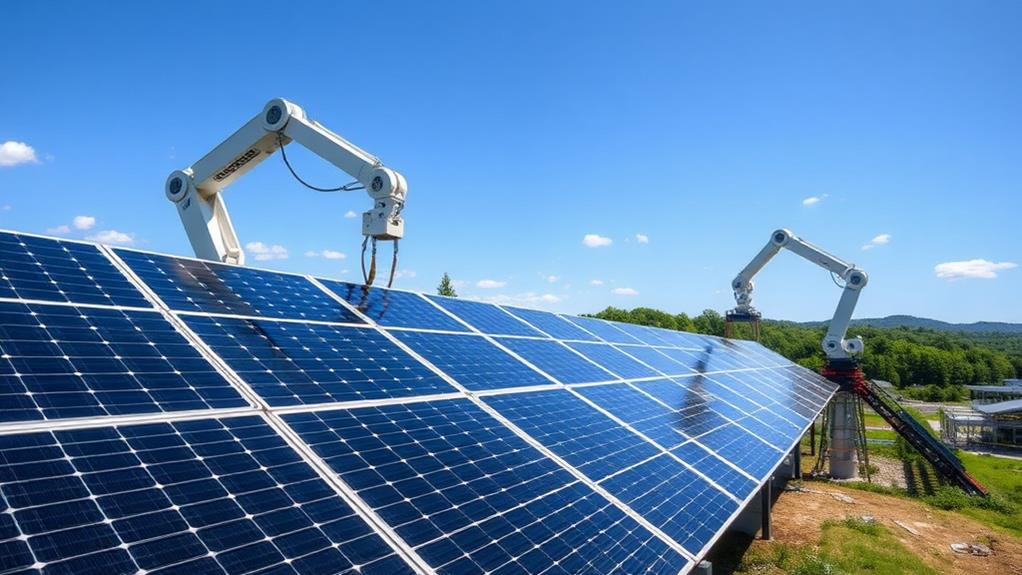Let's tackle troubleshooting solar system problems together. Initially, we'll want to inspect for zero power output due to damaged panels or malfunctioning inverters. A sudden power drop might indicate panel or inverter issues. Don't forget dirty panels or shading can lead to low voltage. Use tools like multimeters and infrared thermometers for accurate diagnostics. It's essential to monitor inverter performance and electrical connections for optimal functioning. Regular maintenance, ensuring panels are clean and connections are secure, enhances efficiency. By addressing these issues, we'll keep our solar systems running smoothly. Together, we can investigate further solutions for peak performance.
Key Takeaways
- Inspect solar panels for damage, dirt, or shading that could impact performance.
- Use multimeters and clamp meters to check for electrical issues in the system.
- Analyze inverter performance by monitoring input and output voltage regularly.
- Check all electrical connections for signs of corrosion, looseness, or damage.
- Conduct regular maintenance and clean panels to enhance system efficiency.
Identifying Common Solar Issues
Identifying the root cause of solar system problems is crucial for maintaining efficient energy production. Understanding common issues is vital for any community committed to sustainable energy.
Solar PV systems may sometimes produce zero power output due to damaged panels or a malfunctioning inverter. A sudden drop in power typically indicates that panels or the inverter require attention. Regular system checks are important to ensure a consistent energy supply.
Low voltage can also impact solar systems. Efficiency can be reduced through dirty panels, shading, or temperature effects. It's important to keep panels clean and free from shade. Products like the Kärcher K2 Compact Pressure Washer can help maintain clean panels, ensuring optimal performance.
Inverter problems can stem from faulty installation, capacity mismatches, or power surges. These issues can disrupt power flow and affect energy output. Electrical problems such as circuit breaker faults or wiring issues can complicate matters further. If troubleshooting efforts fail, it may be necessary to seek professional assistance. Understanding these common issues helps maintain a reliable solar panel system for everyone.
Diagnostic Tools and Methods
Efficient maintenance of our solar systems relies heavily on having the right diagnostic tools and methods. A strong sense of community and shared purpose ensures solar arrays perform optimally. Essential diagnostic tools like multimeters, clamp meters, and solar meters enable precise measurement of current in individual components of our solar PV system. These instruments help monitor voltage, current, and resistance, ensuring every part functions correctly. Regular solar panel maintenance, including visual inspections and system data analysis, aligns with our solar energy objectives.
Infrared thermometers are crucial for detecting temperature variations that might signal issues such as hotspots or shading. IV curve testing offers insights into our solar array's performance. Electroluminescence cameras provide detailed images for identifying microcracks or defects affecting panels. In cases like a blown fuse, prompt replacement maintains the effectiveness of Battery Storage systems.
Embracing these diagnostic tools and methods strengthens solar maintenance, promoting the reliability and longevity of solar systems, and reinforcing our collective commitment to sustainable energy.
Specific examples of recommended products include the Fluke 117 Multimeter for accurate measurement and the HT Instruments SOLAR300N for comprehensive solar analysis. Regular checks and the use of advanced diagnostic equipment ensure that solar systems remain efficient and effective.
Analyzing Inverter Performance
The core of any solar system is its inverter, essential for converting DC power from solar panels into usable AC power for homes and businesses. Monitoring inverter performance indicators, such as input and output voltage, is crucial. This helps assess overall system health and efficiency.
A reliable clamp meter, like the CAT III 1500V rated, is invaluable for measuring the inverter's output on the AC side, providing accurate readings.
In our community of solar enthusiasts, tools like the Fluke 393 FC for troubleshooting are beneficial. This device enables the checking of the inverter's output voltage and identifies potential issues swiftly.
It's important to regularly record the DC input voltage, as fluctuations or irregularities might indicate underlying problems. Addressing utility voltage issues promptly is vital; neglecting them could lead to inverter damage and reduced system efficiency.
Inspecting Electrical Connections
When inspecting electrical connections in a solar system, it's essential to detect signs of corrosion, loose wires, or burnt components that can affect conductivity. These issues can disrupt the system's performance, leading to reduced output and potentially causing inverters to malfunction. Checking each connection for tightness and correct torque helps prevent heat buildup, a frequent cause of fire hazards.
A thermal imaging camera is an effective tool for ensuring the system produces the desired output. It identifies hotspots in electrical connections, highlighting areas that may require attention. Discolouration or melting of insulation around wires is a warning sign of overheating or excessive current flow. Addressing these signs promptly ensures the solar system continues to function optimally.
Regular maintenance, such as tightening and securing connections, is crucial for maintaining system efficiency. Routine checks not only protect the performance of the solar setup but also contribute to a safer environment for everyone involved. Giving electrical connections the attention they deserve ensures solar systems continue to operate efficiently.
Combiner Box Troubleshooting
Combiner box problem-solving is crucial for maintaining a solar system's efficiency. Ensuring solar systems operate at their peak involves focusing on the combiner box, where multiple PV arrays converge. A vital tool is the clamp meter, such as the Fluke 393 FC, which is designed with a thin jaw to measure current even in tight spaces.
Conduct amperage measurements on individual arrays within the combiner box to pinpoint any malfunctions. Calculating combined current measurements confirms everything is functioning correctly. This process resembles detective work, unraveling the mystery of any inefficiencies in the solar setup.
Inspect the combiner box itself. Validate all fuses to ensure they're intact and operational.
Verifying resistance and continuity is vital in troubleshooting solar systems. Ensuring the path of electricity is uninterrupted and efficient is key.
Maintaining Solar Panel Efficiency
Several factors can impact solar panel efficiency. Regular maintenance ensures these systems function optimally. Committing to practices such as solar panel cleaning can enhance efficiency by up to 20%. Dirt and debris block sunlight, reducing the photovoltaic system output. Keeping panels clean ensures they perform effectively.
Monitoring energy production allows for the early detection of common solar panel issues, such as shading or voltage problems, which might otherwise go unnoticed.
Regular checks of electrical connections are essential. Loose connections can lead to energy losses, diminishing the overall efficiency of solar panels. Ensuring the inverter maintains the correct output prevents these inefficiencies.
Inspecting for shading problems is important to identify obstructions that may lower the system's output.
Assessing system performance over time helps track trends and optimize energy production. A proactive approach ensures solar panels operate at their maximum potential. As a community committed to sustainable energy, sharing tips and experiences enables everyone to make the most of their solar investments. Supporting one another in this vital endeavor is crucial.
Conclusion
In conclusion, we've explored how to identify and fix common solar system problems together. By using simple diagnostic tools and methods, checking inverter performance, and looking at electrical connections, we can solve many issues that might arise. Always pay attention to the combiner box and maintain solar panel efficiency for optimal performance. With these steps, we'll ensure our solar systems work smoothly and keep producing green energy for years to come. Let's confidently use solar power!
If you have any questions about our products or services, please contact Deo Solar. We offer a range of products including Rail-Less Solar Brackets, End Spacers, Structural Brackets, Ground Mounted Solar Systems, Corrugated Brackets, and Earthing Plates. Our services include the DeoSizer Tool, Evaluation and Design, Maintenance and Support, and Solar Installations. Reach out to us for more information and support.

